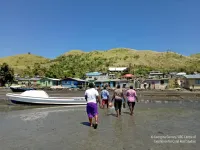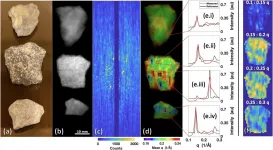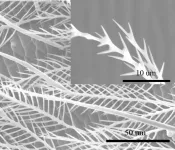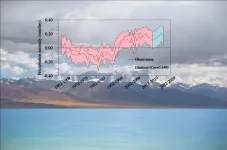More 'fairness' needed in conservation
2021-06-09
(Press-News.org) New research shows what is often assumed to be 'fair' in conservation practice may not be considered so by the very people most affected by it--and a new approach is needed if protected areas are to be effective.
Lead author Dr Georgina Gurney, from the ARC Centre of Excellence for Coral Reef Studies based at James Cook University, said considering local stakeholder conceptions of fairness in conservation is critical.
"If conservation is perceived as unfair it can lead to conflict, undermining support and cooperation," Dr Gurney said.
She said it is not only an ethical matter but key to achieving good outcomes for people and the environment.
"But what is fairness? Very few studies have asked this question in the context of conservation, especially marine protected areas."
The researchers asked Indigenous communities in Fiji (who hold customary tenure rights to land and sea) about the fairness of five alternative approaches to distributing money paid by tourists to dive in a new co-managed marine protected area.
"Our study found local stakeholders considered the 'most fair' way to distribute money from the area was according to who held rights over the area," said co-author Dr Sangeeta Mangubhai, Director of the Wildlife Conservation Society Fiji Country Program.
"They thought the least fair way to distribute money was according to the costs incurred to fishers who were affected by the new rules prohibiting fishing."
The findings challenge common assumptions in much of the conservation literature and practice about what constitutes distributional fairness. These often focus on equality and forgone economic benefits of resource extraction, such as fishing.
"Our findings help clarify fairness in global environmental policies and agreements," Dr Mangubhai said. "Explicitly identifying what is considered fair by those most affected by conservation is important during both the planning and evaluation processes."
"This practice is especially important in low- and middle-income countries. Conservation practice and policy undertaken in these countries are often shaped by that developed in rich Western countries, which means they are underpinned by Western ideas about fairness."
"As the coverage of conservation areas is expected to grow to 30% of the world's surface by 2030, more attention should be given to what local stakeholders consider is fair with regards to related decision-making and the distribution of associated costs and benefits," Dr Gurney said.
"To help make sure existing and new protected areas work, we need to move beyond tacit assumptions about what constitutes fair management to explicit identification of local conceptions of fairness."
"Otherwise, we risk the chance of support for the protected area being eroded."
INFORMATION:
PAPER
Gurney G, Mangubhai S, Fox M, Kiatkoski Kim M, Agrawal A. (2021). 'Equity in environmental governance: perceived fairness of distributional justice principles in marine co-management'. Environmental Science & Policy. DOI: 10.1016/j.envsci.2021.05.022
CONTACT
Dr Georgina Gurney (Townsville, AEST)
P: +61 (0)415 465 712
E: georgina.gurney@gmail.com
Dr Sangeeta Mangubhai (Suva, Fiji, GMT+12)
E: smangubhai@wcs.org
FOR FURTHER INFORMATION
Melissa Lyne/ Coral CoE (Sydney, AEST)
P: +61 (0)415 514 328
E: melissa.lyne@jcu.edu.au
[Attachments] See images for this press release:

ELSE PRESS RELEASES FROM THIS DATE:
2021-06-09
University of Illinois Chicago researchers studying birth outcomes in marmoset monkeys found there were no adult maternal characteristics like age or weight gain during pregnancy to predict stillbirth or early neonatal death, but that a mother's birth weight or litter size were associated with early neonatal death.
"Our findings of early life contributions to adult pregnancy outcomes in the common marmoset disrupt mother-blaming narratives of pregnancy outcomes in humans," the paper states.
Julienne Rutherford, associate professor at UIC's School of Nursing, is lead author of "Womb to Womb: Maternal litter size and birth weight but not adult characteristics predict early neonatal death of offspring in the common marmoset monkey" published in the journal PLOS ONE.
Marmosets ...
2021-06-09
Since the early days of the COVID-19 pandemic, there were questions about how people in active cancer treatment would fare if they became infected with SARS-CoV-2. The worries were due, in large part, to the effects that cancer and its treatments can have on the immune system. Now that COVID-19 vaccines are widely available, concerns have shifted to the safety and effectiveness of vaccination in this potentially vulnerable population. A study published June 5 in the journal Cancer Cell aims to allay those fears.
In a review of 200 patients with a wide spectrum of cancer diagnoses, researchers at Montefiore Health System and Albert Einstein College of Medicine in the Bronx, NY, found that after full vaccination, 94% of patients overall demonstrated seroconversion, ...
2021-06-09
The routes and schedules of public transit, the presence or absence of sidewalks, the availability of different transportation options, and the design of highways that divide cities--these are examples of aspects of transportation systems that can profoundly impact underserved communities' access to basic needs like jobs, health care, education and even food.
A new study by University of Michigan researchers reveals common barriers that transportation decision-makers face in considering these issues and addressing them.
To conduct the study, a team from a multidisciplinary project involving engineering, ...
2021-06-09
DARIEN, IL - A study shows that a deep neural network model can accurately predict the brain age of healthy patients based on electroencephalogram data recorded during an overnight sleep study, and EEG-predicted brain age indices display unique characteristics within populations with different diseases.
The study found that the model predicted age with a mean absolute error of only 4.6 years. There was a statistically significant relationship between the Absolute Brain Age Index and: epilepsy and seizure disorders, stroke, elevated markers of sleep-disordered breathing (i.e., apnea-hypopnea index and arousal ...
2021-06-09
The widely studied metallic asteroid known as 16 Psyche was long thought to be the exposed iron core of a small planet that failed to form during the earliest days of the solar system. But new University of Arizona-led research suggests that the asteroid might not be as metallic or dense as once thought, and hints at a much different origin story.
Scientists are interested in 16 Psyche because if its presumed origins are true, it would provide an opportunity to study an exposed planetary core up close. NASA is scheduled to launch its Psyche mission in 2022 and arrive at the asteroid in 2026.
UArizona ...
2021-06-09
[RALEIGH, N.C.] - How are the squirrels doing this year? The bears? The armadillos? How would you know? A new paper published June 8 sets up the framework for answering these questions across the United States by releasing the data from the first national mammal survey made up of 1,509 motion-activated camera traps from 110 sites located across all 50 states.
Unlike birds, which have multiple large-scale monitoring programs, there has been no standard way to monitor mammal populations at a national scale. To address this challenge, scientists from the North Carolina Museum of Natural Sciences and the Smithsonian Conservation Biology Institute recently collaborated ...
2021-06-09
DURHAM, N.C. - Engineers at Duke University have demonstrated a prototype X-ray scanning machine that reveals not just the shape of an object but its molecular composition. With unprecedented resolution and accuracy, the technology could revolutionize a wide range of fields such as cancer surgery, pathology, drug inspection and geology.
Many of the ideas behind the prototype were originally conceived in the pursuit of performing better bomb detection for aviation security. In the new paper, published online May 19 in the journal Scientific Reports, the researchers adapted the technology for several targeted scientific and medical applications.
"Whether you're trying to spot a bomb in a bag or a tumor in a body, the physics is more or less the same," said ...
2021-06-09
Watching honeybees buzz among flowers, it's easy to see how the expression "busy as a bee" arose. One of many movements a bee's body makes is the repetitive curving and straightening of its abdomen. Now, researchers reporting in ACS Applied Materials & Interfaces have found that tiny hairs reduce friction from these motions, saving energy for the industrious insects' daily activities while reducing wear and tear. This knowledge could help researchers design longer-lasting moving parts.
A bee's abdomen is divided into several tough outer plates that make up its exoskeleton. When the abdomen flexes and extends, these segments slide over each other, creating friction. However, the overlapping portions of the segments show very little wear and tear, ...
2021-06-09
WASHINGTON, June 9, 2021 -- The World Health Organization and the Centers for Disease Control recommend keeping a certain distance between people to prevent the spread of COVID-19. These social distancing recommendations are estimated from a variety of studies, but further research about the precise mechanism of virus transport from one person to another is still needed.
In Physics of Fluids, by AIP Publishing, researchers from Stony Brook University, Harvard, ETH Zurich, and Hanyang University demonstrate normal breathing indoors without a mask ...
2021-06-09
Summer rainfall on the Tibetan Plateau is highly predictable on multiyear timescales in large ensemble predictions, according to a research team led by ZHOU Tianjun from the Institute of Atmospheric Physics (IAP) of the Chinese Academy of Sciences.
The study, published in Science Advances on June 9, shows evidence that the predictable signal of summer rainfall across the hinterland of the Tibetan Plateau is substantially underestimated in state-of-the-art decadal prediction models.
The predictable signal is so weak that it can be concealed by unpredictable noise. "The too weak predictable signal arises from the low signal-to-noise ratios in models in comparison with the real world," ...
LAST 30 PRESS RELEASES:
[Press-News.org] More 'fairness' needed in conservation




